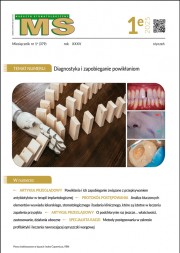Multiplanar analysis of temporomandibular disc position on magnetic resonance images in patients with clinical symptoms of temporomandibular joint disorders
Monika Litko, Jacek Szkutnik, Marcin Berger, Ingrid Różyło-Kalinowska
Streszczenie
Wprowadzenie. Zaburzenia funkcjonowania kompleksu głowa żuchwy – krążek stawowy są prawdopodobnie najczęściej występującymi zaburzeniami u pacjentów z dysfunkcjami układu ruchowego narządu żucia.
Cel pracy. Analiza położenia krążków stawowych stawów skroniowo-żuchwowych (ssż) w obrazie rezonansu magnetycznego (MR) u pacjentów z objawami klinicznymi przemieszczenia krążków stawowych ssż.
Materiał i metody. Przeprowadzono wieloprzekrojową analizę obrazów MR ssż wykonanych u 191 pacjentów w płaszczyźnie strzałkowej i czołowej w maksymalnym zaguzkowaniu zębów i w rozwarciu.
Wyniki. Analiza obrazów MR 382 ssż wykazała prawidłowe położenie krążka w 89 (23,3%) przypadkach, częściowe doprzednie w części bocznej w 22 (5,8%), częściowe doprzednie w części przyśrodkowej w 3 (0,8%), całkowite doprzednie w 74 (19,4%), częściowe doprzednio-boczne w 25 (6,5%), całkowite doprzednio-boczne w 67 (17,5%), częściowe doprzednio-przyśrodkowe w 7 (1,8%), całkowite doprzednio-przyśrodkowe w (9,4%), boczne w 17 (4,5%) i przyśrodkowe w 42 (11,0%) przypadkach.
Wnioski. Wieloprzekrojowa analiza położenia krążków stawowych stawów skroniowo-żuchwowych w obrazie MR pozwala na precyzyjne zróżnicowanie poszczególnych typów przemieszczeń krążków stawowych ssż zarówno w płaszczyźnie strzałkowej, jak i w czołowej.
Abstract
Background. The most common temporomandibular joint (TMJ) internal derangement is an abnormal relationship of the disc with respect to the mandibular condyle and glenoid fossa.
Objectives. The aim of the study was to analyze the temporomandibular disc position on magnetic resonance imagines in patients with clinical symptoms of TMJ disc displacement.
Material and methods. MRI analysis was carried out in 191 patients. Disc position was evaluated on all oblique sagittal and coronal images in the intercuspal and open-mouth positions.
Results. The analysis of 382 MR scans revealed normal disc position in 89 (23.3%) cases, partial anterior in the lateral part in 22 (5.8%) cases, partial anterior in the medial part in 3 (0.8%), complete anterior in 74 (19.4%), partial anterolateral in 25 (6.5%), complete anterolateral in 67 (17.5%), partial anteromedial in 7 (1.8%), complete anteromedial in 36 (9.4%), lateral in 17 (4.5%) and medial in 42 (11.0%) cases.
Conclusion. Multiplanar analysis of MR images allows distinguishing the correct disc position from various types of TMJ disc displacement in the sagittal and coronal plane.
Hasła indeksowe: choroby stawu skroniowo-żuchwowego, krążek stawu skroniowo-żuchwowego, obrazowanie rezonansem magnetycznym
Key words: temporomandibular joint disorders, temporomandibular joint disc, magnetic resonance imaging
PIŚMIENNICTWO
1. LeResche L.: Epidemiology of temporomandibular disorders: implications for the investigation of etiologic factors. Crit. Rev. Oral Biol. Med., 1997, 8, 3, 291-305.
2. Carlsson G.E.: Epidemiology and treatment need for temporomandibular disorders. J. Orofac. Pain.,1999, 13, 4, 232-237.
3. Macfarlane T.V., Glenny A.M., Worthington H.V.: Systematic review of population-based epidemiological studies of orofacial pain. J. Dent., 2001, 29, 7, 451-467.
4. Progiante P.S. i wsp.: Prevalence of temporomandibular disorders in an adult Brazilian community population using the research diagnostic criteria (axes I and II) for temporomandibular disorders (The Maringá Study). Int. J. Prosthodont., 2015, 28, 6, 600-609.
5. Kleinrok M.: Zaburzenia czynnościowe układu ruchowego narządu żucia. Wyd. Czelej, Lublin 2012.
6. Schiffman E. i wsp.: Diagnostic Criteria for Temporomandibular Disorders (DC/TMD) for Clinical and Research Applications: recommendations of the International RDC/TMD Consortium Network and Orofacial Pain Special Interest Group. J. Oral Facial Pain Headache, 2014, 28, 1, 6-27.
7. Schmitter M., Kress B., Rammelsberg P.: Temporomandibular pathosis in patients with myofascial pain: a comparative analysis of magnetic resonance imaging and a clinical examination based on a specific set of criteria. Oral Surg. Oral Med. Oral Pathol. Oral Radiol. Endod., 2004, 97, 3, 318-324.
8. Hardison J.D., Okeson J.P.: Comparison of three clinical techniques for evaluating joint sounds. Cranio, 1990, 8, 4, 307-311.
9. Yatani H. i wsp.: The validity of clinical examination for diagnosing anterior disk displacement without reduction. Oral Surg. Oral Med. Oral Pathol. Oral Radiol. Endod., 1998, 85, 6, 654-660.
10. Larheim T.A., Westesson P., Sano T.: Temporomandibular joint disk displacement: comparison in asymptomatic volunteers and patients. Radiology, 2001, 218, 2, 428-432.
11. Tasaki M.M,. Westesson P.L.: Temporomandibular joint: diagnostic accuracy with sagittal and coronal MR imaging. Radiology, 1993, 186, 3, 723-729.
12. Molinari F. i wsp. Temporomandibular joint soft-tissue pathology. I: Disc abnormalities. Semin. Ultrasound CT MR, 2007, 28, 3, 192-204.
13. Ikeda K., Kawamura A.: Disc displacement and changes in condylar position. Dentomaxillofac. Radiol., 2013, 42, 3, 84227642.
14. Kobs G. i wsp. Critical assessment of temporomandibular joint clicking in diagnosing anterior disc displacement. Stomatologija, 2005, 7, 1, 28-30.
15. Cai X.Y., Jin J.M., Yang C.: Changes in disc position, disc length, and condylar height in the temporomandibular joint with anterior disc displacement: a longitudinal retrospective magnetic resonance imaging study. J. Oral Maxillofac. Surg., 2011, 69, 11, 340-346.
16. De Farias J.F.G. i wsp.: Correlation between temporomandibular joint morphology and disc displacement by MRI. Dentomaxillofac. Radiol., 2015, 44, 7, 20150023.
17. Kleinrok M. i wsp.: Przemieszczenie krążków stawów skroniowo-żuchwowych i głów żuchwy w płaszczyźnie czołowej w maksymalnym zaguzkowaniu zębów. Badania metodą rezonansu magnetycznego i
tomografii komputerowej. Czas Stomatol., 2003, 56, 8, 543-553.
18. Kleinrok M.: Odległe objawy czynnościowe i wegetatywne u chorych ze złożonymi przemieszczeniami krążków stawowych stawów skroniowo-żuchwowych w maksymalnym zaguzkowaniu zębów – doniesienie wstępne. Protet. Stomatol., 2009, 59, 4, 20120199 .
19. Eberhard L. i wsp.: Temporomandibular joint (TMJ) disc position in patients with TMJ pain assessed by coronal MRI. Dentomaxillofac. Radiol., 2013, 42, 6, 343-352.
20. Tasaki M.M. i wsp.: Classification and prevalence of temporomandibular joint disk displacement in patients and symptom-free volunteers. Am. J. Orthod. Dentofacial Orthop., 1996, 109, 3, 249-262.
21. Schmitter M. i wsp.: Validity of temporomandibular disorder examination procedures for assessment of temporomandibular joint status. Am. J. Orthod. Dentofacial Orthop., 2008, 133, 6, 796-803.
22. Robinson de Senna B. i wsp.: Condyle-disk-fossa position and relationship to clinical signs and symptoms of temporomandibular disorders in women. Oral Surg. Oral Med. Oral Pathol. Oral Radiol. Endod., 2009, 108, 3, e117-124.
23. Yatani H. i wsp. The validity of clinical examination for diagnosing anterior disk displacement with reduction. Oral Surg. Oral Med. Oral Pathol. Oral Radiol. Endod., 1998, 85, 6, 647-53.














